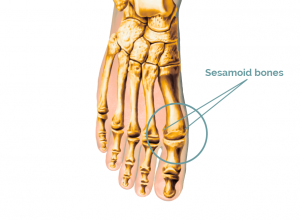
Sesamoiditis
Sesamoiditis is a form of tendinitis characterized by painful inflammation of the tendons surrounding sesamoid bones, which are bones that are not connected to other bones via a joint but rather only via a tendon. Examples of sesamoid bones include the kneecap and two tiny, pea-shaped sesamoids located on the underside of the forefoot near the big toe. The sesamoids in the foot act as pulleys for the tendons in the big toe, helping the toe push off during walking and other forms of physical activity. They also help bear the weight of the body during walking, running and jumping.
Symptoms
Sesamoiditis causes pain and inflammation in the area surrounding a sesamoid bone. Sesamoiditis of the foot typically creates these sensations on the inner (medial) and plantar area of the foot. The pain can appear suddenly, as is the case for sesamoid fractures, or it can gradually build. Some cases of sesamoiditis are aggravated by movement of the big toe and others may be accompanied by edema (swelling). Sesamoiditis generally does not create redness or bruising of the affected area.
Causes
Sesamoiditis is generally associated with physical activities that create repetitive extra pressure on the ball of the foot, including running, sports and ballet. Frequently wearing high heels can also create sesamoiditis, as can stress fractures (microscopic tears in the bone) from repetition and overuse.
Treatment
Most cases of sesamoiditis can be treated at home. Treatment steps include stopping any activity that causes pain, resting, using ice to help with swelling, and taking over-the-counter pain medication and oral anti-inflammatory drugs (NSAIDs). It is also recommended that people with sesamoiditis wear comfortable shoes or orthotic footwear and add metatarsal pads in the shoes. Some doctors may recommend steroid injections, physical therapy and a short leg fracture brace for several weeks.
If the sesamoid bones are fractured, an orthopaedic surgeon may recommend you wear a short leg fracture brace or J-shaped pad around the area of the sesamoid bones as well as tape the joint to limit movement of the big toe.
Notice concerning medical entries:
Articles having medical content shall serve exclusively for the purpose of general information. Such articles are not suitable for any (self-) diagnosis and treatment of individual illnesses and medical indications. In particular, they cannot substitute for the examination, advice, or treatment by a licensed physician or pharmacist. No replies to any individual questions shall be effected through the articles.






